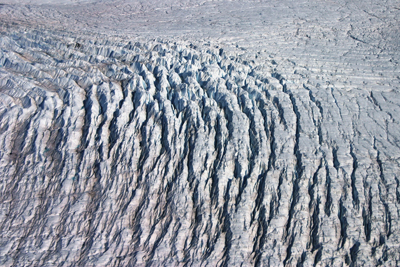Source: Reviews of Geophysics
Crevasses—cracks caused by stresses due to ice movement—score the surface of nearly every glacier on Earth. Although crevasses can span just a few millimeters in width and depth, some are tens of meters wide or deep and can stretch for hundreds of meters along a glacier.
Scientists routinely use crevasses to study not only the form and flow of glaciers but also how they may amplify glacier response to climate change. However, crevasses can also obscure ice core records or annual layering patterns, and they pose safety hazards to scientists and their equipment.
In a new study, Colgan et al. review 6 decades of glacier crevasse field research as well as satellite observations and computer modeling. Scientists have long ventured onto glaciers to study the pushing and pulling forces that produce crevasses. It is well known that after a crevasse opens, ice flow can transport it downstream, curving and rotating it on the way. Newer studies, however, now show that competing fracture processes can produce rotated and curved crevasses without downstream transport. The authors note that older studies may need to be reinterpreted in the context of such new insights.
Recent direct observations of glaciers also show mounting evidence that contrary to long-standing assumptions, crevasse formation can begin at depth within the ice and not at the surface. The authors say this could present a paradigm shift for interpreting “buried” crevasses.
High above the ice, remote observations have also shed new light on crevasses. Satellites have yielded unprecedented high-resolution images of crevasse patterns around the world. These images have shown that crevasse fields are not static, but instead change through time—ultimately, in response to climate. The authors say that autonomous ground vehicles and aircraft equipped with ground-penetrating radar could further uncover previously unattainable details of crevasse life cycle.
The team also reviewed crevasse modeling techniques. Despite recent transformative improvements in large-scale glacier flow models, the most popular small-scale models that simulate crevasse formation have remained mostly unchanged for at least 20 years. The authors propose combining recently developed ice fracture simulations with large-scale models to gain insight into the spatial distribution of crevasses over time.
Rounding out their review, the team discusses how crevasse mechanisms influence meltwater production and retention in the context of climate change. For example, crevassed glacier surfaces more readily trap solar radiation than noncrevassed surfaces, promoting melting. However, much more knowledge is needed to understand just what the climate change impacts of crevasses will be. (Reviews of Geophysics, doi:10.1002/2015RG000504, 2016)
—Sarah Stanley, Freelance Writer
Citation: Stanley, S. (2016), Recent studies crack open new views of glacial crevasses, Eos, 97, doi:10.1029/2016EO047897. Published on 16 March 2016.
Text © 2016. The authors. CC BY-NC 3.0
Except where otherwise noted, images are subject to copyright. Any reuse without express permission from the copyright owner is prohibited.


